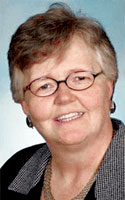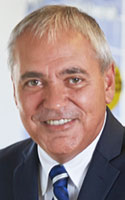Analysis of some of the key sectors of the local economy
By Lou Sorendo
1 Agriculture
As 2020 unfolds, the Oswego County agricultural community is awaiting proposed changes to a bill that looks to threaten its very well being.
Gov. Andrew Cuomo recently unveiled his 2020 budget plan, and in it, he proposes changes to the Farm Laborers Fair Labor Practices Act. The law protects farm worker rights and ensures every farm worker benefits from the basic labor protections and rights that all other workers in the state have.
One provision of the law that the New York Farm Bureau is seeking to change involves the definition of the word “family,” said Mark James, senior field adviser-membership strategy specialist for the New York Farm Bureau.
“The law says that you have to pay extended family members overtime, and provide disability insurance and workers’ compensation,” James said. “For a small family, that is very onerous.”
The law that is in effect exempts only immediate family members from the law, such as a husband, wife and children.
However, the typical family farm involves members of the extended family as well, such as aunts, uncles and cousins.
James said he spoke with an area farmer whose farm has been in the family for 180 years. The farmer now has four grandsons involved in the operation, and says he cannot endure these additional costs.
“The future of this farm would be in jeopardy because of this law,” James said. “However, the governor has listened to us and put language in the budget to basically extend the exemption onto extended family members.”
If that provision remains in the budget package and is passed by April 1, then it would take effect immediately “just to provide some clarity and guidance to the farm community,” James said.
He noted farming families are big, not just the traditional versions in Oswego County, but also among the Amish community.
“This is definitely going to effect how the Amish do business, because they have large extended families,” he said. “This would be a huge burden on those small Amish farms.”
There are 33,400 farms are in operation today in New York state, 96% of which are family-owned.
The act took effect Jan. 1, and also allows collective bargaining and unionization of farm workers.
It also created a wage board that is directed by legislation to make a report to the governor regarding any needed changes in the law in March.
James said the bureau would like to see the wage board expanded beyond its current three-person format. One is appointed by the Department of Labor, another by the New York State AFL-CIO and the third is the president of the New York State Farm Bureau.
“We’d like to see some broader representation because right now, it’s stacked 2-to-1 against us. We’d like to see that put in place as well,” he added.
The migrant worker situation
Thanks to immigration control, U.S. borders have been tightened and there are fewer people coming into the country, James said.
He said the good news is area vegetable crop growers can access the federal H-2A visa program, designed to establish means for agricultural employers to bring eligible non-immigrant foreign workers to the U.S.
However, James said it is a “very costly and cumbersome program.”
“We certainly are trying to make some changes to that program,” said James, noting that President Trump recently spoke at an American Farm Bureau meeting and talked about the adverse effect wage rate, or a minimum wage that the Department of Labor determined must be offered and paid to U.S. and alien workers by agricultural employers of nonimmigrant H-2A visa agricultural workers.
In addition, farmers must pay for migrant workers’ transportation from and to their native country, and must provide housing and transportation to accommodate any personal needs.
“It’s all politics. You have a crowd that wants everybody kicked out of the country and a crowd that has a more tolerant approach,” he said.
Dairy is king
Milk is by far the largest agricultural commodity in the state and represents 47% of the state’s total agricultural sales. In Oswego, the dairy sector ranks No. 1 in sales while vegetables are No. 2.
“We’ve obviously gone through some attrition within the dairy industry over the last several years. We’ve had four years of low milk prices. The good news is the price of milk is inching up now, but unfortunately, we’ve had four years where farmers were receiving payments that were below the cost of production. So, they’ve had to go into debt and extend their credit line,” he said.
Projections foresee prices heading up to $20 per hundredweight for milk over the coming months, he noted.
“That’s all good news, but now farmers have to pay off that debt they accrued over the last four years,” he noted.
Another significant step forward is the signing of the U.S.-Mexico-Canada trade agreement.
“This should provide some relief for dairy farmers in terms of additional exports of milk and milk products to Canada and Mexico,” he said.
Canada and Mexico are the top two export markets for U.S. food and agricultural products, totaling nearly $40 billion last year and equating to 325,000 jobs.
James also noted trade agreements with both China and Japan bode well for the agricultural industry.
“We ship milk products to the Pacific Rim from this region, and so again, we are finding more markets for milk, which is going to obviously help prices. It’s all supply and demand, and the more demand for a product there is, the higher price a farmer will get,” he added.
Meanwhile, New York ranks second among the states for production of apples and maple syrup.
James noted apples as well as maple syrup production in Oswego County continues to be significant.
In terms of apples, farmers have seen a drop in prices and a glut on the market in terms of supply, and have been looking at ways of diversifying and finding more markets for their products, James added.
Maple syrup, meanwhile, has been “a real bright spot” in the county, he said.
According to the latest U.S. Department of Agriculture statistics, Oswego County featured 31 farms producing maple syrup, 15,000 taps and the ability to make about 3,500 gallons of maple syrup.
That compares to previous Census numbers that saw 17 farms and nearly 13,000 taps producing about 2,500 gallons of maple syrup.
“That’s been an industry that has expanded over the past several years in Oswego County,” he noted.
2 Higher Education
County’s top employer driving force in Oswego County economy

Deborah Stanley.
SUNY Oswego, an economic engine in Oswego County and throughout the Central New York region, is addressing the skills gap in the region that is considered the most pressing issue facing industries.
The college is the largest employer in Oswego County with 4,993 full-time, part-time and student employees.
“These members of our campus community reinvest back into the community on a daily basis,” said SUNY Oswego President Deborah F. Stanley. “Yet, it is important that we shine a light on the linkage that exists between business and academia and the collaborative efforts that are taking place to grow and invest in our talent pool and skilled workforce.”
Industries throughout Oswego County and the CNY region rate the recruitment of a skilled and trained workforce as one of their most significant issues and a contributing factor in their ability to operate and grow their business today, Stanley noted.
SUNY Oswego is the largest state university in the region with 7,986 students.
“Our curriculum includes high-demand, high-quality, innovative degree programs developed with industry and business partners in mind,” Stanley said.
Examples include its electrical and computer engineering and software engineering programs, recently accredited by the engineering accreditation commission of the Accreditation Board for Engineering and Technology; the school’s new biomedical health informatics graduate program; and SUNY Oswego’s online Master of Business Administration, ranked No. 1 among New York state public colleges and No. 3 overall in New York.
Stanley serves as co-chairwoman of CNY’s Regional Economic Development Council.
“This allows me to bring a deep understanding of higher education’s ability to deliver innovation, and also how to use talent to fully leverage our competitiveness in key sectors such as health, technology and education,” she said.
Significant growth sector
Over the past 20 years, SUNY Oswego has invested more than $900 million in academic, residential and infrastructure enhancements to better support the mission of the college and enhance the experience of the campus community, Stanley said.
Over the past five years of campus renovations and new construction, SUNY Oswego’s capital plan projects exceeded $69 million and injected more than $37 million into New York’s economy.
As the college looks ahead to 2020 and beyond, the following projects are high on its capital improvement priority list:
• Breaking ground on Hewitt Hall: SUNY Oswego will break ground this year on an $80 million renovation of Hewitt Hall. This is a capital investment project aimed at transforming Hewitt Hall and SUNY Oswego’s graphic design, broadcasting, communication and media facilities into one of the best in the nation.
• A rehabilitation project will continue on the Funnelle residence hall in 2020, with work to focus on the renovation of all floors, including common spaces, bathrooms, roof and the replacement of major core utilities.
• In the next five years, SUNY Oswego looks to invest an additional $35 million in its capital projects that will result in increased jobs, direct labor costs, and the purchase of materials that together will have a substantial impact on the local, regional and state economies.
These planned projects include the Hewitt Quad renovation, Seneca Hall refurbishment, and the creation of the Lanigan-Penfield Connector, which will integrate Lanigan Hall and Penfield Library into a larger, connected complex with more unified internal functions.
‘Town-gown’ bond
Stanley said a strong “town-gown” relationship between the city of Oswego and SUNY Oswego contributes to the economic vitality of the area.
“SUNY Oswego’s vast intellectual and creative resources are uniquely and systematically positioned to provide collaborative opportunities that support and strengthen the local Oswego community and the region,” she said.
“This engagement is central to the core mission of our campus by linking faculty, staff and students to external business, industry and community impacts,” she added.
Stanley noted SUNY Oswego campus organizations completed 10,025 hours of community service with monetary charitable impacts of more than $80,000 last year.
“From experiential learning and career preparation, to community-engaged learning and service, to building awareness of the college as a vital community resource, external engagement adds value to the student experience and to the college as a whole,” Stanley said.
She said a shared vision for building external partnerships includes student and faculty alignment with business and industry practices and trends, business and industry alignment with program and curriculum development, and supporting the needs of external partners in the community and region.
Stanley said SUNY Oswego is also committed to maintaining and strengthening positive relations between the college and city of Oswego.
The college’s chief diversity and inclusion officer, Dr. Rodmon King, serves as chairman of Mayor William Barlow’s Campus-City Relations Committee.
Members of the CCRC meet regularly to initiate dialogue among residents, students, landlords, business owners, local law enforcement, college administrators and the mayor’s office.
“The work of the CCRC strives to make clear that all members of the greater Oswego community benefit when our collective energies blend to create a more vital, vibrant and inclusive living and working environment,” Stanley said.
3 Human Services
Nonprofit/Human Services

Human services are key connectors in Oswego County’s communities, providing resources and supports to help people build a self-sustaining future that would be out of reach otherwise, according to Diane Cooper-Currier, executive director of Oswego County Opportunities, the leading human services organization in the area.
OCO’s mission is accomplished through the combined efforts of nearly 600 employees and approximately 1,200 volunteers. The team delivers a needed array of services to nearly 16,000 individuals annually.
“OCO collaborates with many other agencies so that all of us can be more effective,” said Cooper-Currier, noting that many OCO programs have formal partnerships and contracts with other nonprofits or educational institutions that provide an important role in program delivery.
“Working together assures there is less duplication of services and that resources are being utilized the most efficiently and effectively,” she noted. “That being said, we continue to struggle to meet needs in certain areas.”
She said the need for safe, affordable, accessible and permanent housing continues to exceed the supply.
“Progress is being made, but more needs to be done, especially in the more rural areas of our county,” Cooper-Currier said. “The lack of mental health services places a burden on county residents in need, as waiting lists are long and they often must travel long distances for care.”
Additionally, many human services are primarily available in the cities of Fulton and Oswego, which challenges residents without their own transportation in the more rural areas of the county on figuring out how to get to services, she said.
“A more robust public transit coupled with private transportation services is needed as well as bringing these services to rural communities,” the OCO leader said.
Environment of uncertainty
Cooper-Currier said stability in the human services sector is a “very rare” concept.
She said the primary funding for nonprofits are often government grants, and the nature of this funding is in constant flux and often dependent on local, state and federal agendas and priorities.
“As a human service agency, we must be flexible, nimble and creative to use these resources and others to sustain and maintain what we currently do and look for opportunities to strengthen our services and meet changing community needs,” she said.
Cooper-Currier noted OCO does an excellent job at examining community needs, finding resources to meet these needs and continuing these services in a funding environment that is constantly changing.
Some new opportunities in 2020 for OCO include opening a new home for developmentally disabled adults in the village of Hannibal, and continuing renovations on existing homes throughout the county to accommodate aging residents.
OCO is also partnering with an affordable housing developer to build a significant number of affordable housing units in Pulaski, she said.
“With our partners through LIFT [Learn, Identify, Focus and Transform] Oswego County, a collaboration focused on increasing economic self-sufficiency for those in poverty, we are exploring opportunities and developing a more effective, systemic approach for lifting people out of poverty,” she added.
“OCO does not do this work alone. We rely on our private and government funders, business and community partners, schools and other nonprofits to help people, support this community and change lives,” Cooper-Currier said.
4 Real Estate
Still a sellers’ market as home prices nudge upwards; shortage of inventory continues

The sellers’ market that prevailed in 2019 on the Oswego County real estate scene is expected to spill over into 2020.
That is according to Florence Farley, sales agent with Berkshire Hathaway HomeServices CNY Realty in Oswego.
Farley noted there is still is a shortage of homes for sale in Oswego County, and trend that has existed for several years.
According to the New York State Association of Realtors, there were only 1,579 new home listings in 2019 in Oswego County.
“That is only about a four-month supply of inventory,” Farley said.
Months of supply is the measure of how many months it would take for the current inventory of homes on the market to sell, given the current pace of home sales. Farley said a healthy, balanced market would feature approximately five to seven months of available inventory.
Economists for the National Association of Realtors (NAR) expect only about a 4% increase in new and existing home sales in 2020.
“That is good news for sellers, but can create higher prices for buyers,” she said.
In terms of cost, the median sales price of a home in Oswego County in 2019 improved by 7.2% from the previous year.
Farley said that translates to a buyer paying $111,300 for a home versus $103,800 the previous year.
“That again is good news for sellers and the local tax base, she added.
The factors that control these prices are the limited inventory of available houses, the fact that there are fewer new starts in construction, the low rate of unemployment and low interest rates that are able to support the housing demand, she said.
Meanwhile, Lawrence Yun, chief economist for the NAR, and Gay Cororaton, senior economist for the NAR, expect the 2020 average interest rate to be around 3.8%.
That makes home ownership affordable, “especially for the 25- to 40-year-olds who accounted for the largest segment of home buyers last year,” Farley said.
With that said, Farley said, investors and economists also caution that a number of events can impact the Federal Reserve’s ability to maintain the federal funds rate.
Those include the upcoming U.S. presidential election, Brexit [the withdrawal of the United Kingdom from the European Union], the outcome of Phase 2 of the U.S.-China trade negotiations and the pending U.S.-Mexico-Canada trade agreement.
A recent Wall Street Journal article points out that with interest rates below 2%, the Federal Reserve and central banks can’t lower them further and “we may be looking at the need for a new business cycle model,” Farley said.
All of the most recent projections by economists are that the economy will grow modestly and at a slightly slower pace, Farley said.
“As usual, much depends upon the behavior of our federal and state governments when it comes to tariffs and investment,” she noted.
Farley noted Oswego County is in the midst of a number of revitalization efforts to promote business vitality, an improved tax base and job creation.
“From the city of Fulton being granted $10 million in Downtown Revitalization Initiative funding to invest in its community to the ongoing renaissance in the city of Oswego to our $3.1 billion agricultural community, the atmosphere and outlook is better than it has been in years,” she said.
She said all play a key role in the overall CNY Rising initiative that coordinates the efforts of five counties to grow the economy, bring in new jobs and reduce poverty in rural communities.
CNY Rising is a strategic plan developed by the Central New York Regional Economic Development Council that identifies key strategic investment areas and initiatives, prioritizing investments based on regional strengths and opportunities for growth.
Farley said commercial real estate in Oswego County has improved as well. One example is the expansion of home décor giant MacKenzie-Childs into a vacant 200,931 square-foot warehouse in Volney that is expected to employ up to 55 workers.
Renewed enthusiasm
William Galloway, broker-owner of Century 21 Galloway Realty in Oswego, said there seems to be a spirit of renewal in the city of Oswego, particularly due to the success of the $10 million DRI program funded by the state.
“The DRI has sparked a lot of development into not only downtown but throughout the entire community,” Galloway said. “At Century 21 Galloway Realty, we have been very active dealing with both new developers from our area and developers from other areas looking at the Oswego community.”
As U.S. homebuilding increased last November, pending sales and new listings rose year-to-date in New York state compared to that time in 2018, according to a housing market report released recently by the NYSAR.
“I have noticed an upward swing in new construction in the Oswego community over the past five years,” Galloway said. “The real estate market has remained strong but there is still a lack of inventory available for all new buyers in our market.”
The number of homes for sale did increase by nearly 7% last November compared to year-ago figures in Oswego County.
“Homes sales will remain strong and listings are expected to really begin to be more active,” said Galloway, noting the market last year saw Century 21 Galloway Realty have a record year for number of units sold as well as gross commission.
“Century 21 Galloway Realty was once again the leader in residential and commercial real estate in Oswego County for 2019,” he noted.
The median sales price of a home in Oswego County rose more than 18% to $130,000 when comparing prices in November 2019 to November 2018.
Galloway said the median sales price of homes has increased because it has been a sellers’ market and a home priced at market value has received multiple offers many times in an extremely active market.
“I would forecast the same trend for 2020 as we saw in 2019,” he said.
5 Health Care
Oswego Health, ConnextCare continue role as major economic catalysts in county

One of the most significant economic development projects in the county in 2020 will be the creation of Oswego Health’s new behavioral health services facility. It will be built specifically to provide specialized inpatient and outpatient care.
“Our commitment to mental health in the community is expanding and in the fall, Oswego Health will open the new behavioral health services location, transforming mental health care,” said Michael Harlovic, president and CEO of Oswego Health.
The health system will renovate 42,000 square feet of what was once a former grocery store to feature 32 inpatient beds.
“Patients will find the new location offers a welcoming, soothing and healing environment that includes secure outdoor spaces, comfortable interior areas and a kitchen area,” Harlovic said.
The building itself will be landscaped to match the neighborhood and will be well-maintained, he added.
“Our vision is that this new prestigious facility will become a model that’s implemented across the United States for this specialized care,” he added.
Primary care services will be available onsite to assist those who utilize these services become healthier overall.
Services that are offered at the Bunner Street location, the outpatient clinic and through the Assertive Community Treatment Team also will be relocated to the new facility.
It is anticipated that 150 staff members will be at this new location.
Meanwhile, Oswego Health has projects and initiatives planned this year that bode well for the area from an economic development standpoint.
A few key initiatives it is working on this year include:
• The emergency room at Oswego Hospital will be renovated to include a pediatric-friendly room to accommodate the hospital’s youngest emergency department patients.
• Oswego Health is investing more than $7.6 million to renovate Oswego Hospital’s third and fourth floors featuring 44 private rooms with their own bathrooms that offer a hotel-like feel.
“These comfortable and attractive private rooms will lead to safer, quicker healing. Plans also include comfortable areas for families and loved ones,” Harlovic said.
Matter of quality, access
“Our mission for Oswego Health is to provide accessible, quality care and improve the health of residents in our community Harlovic said.
“We have stayed true to this mission since the hospital started back in 1881, when our founders were determined to provide care to all residents, regardless of income and other factors,” he added.
They desired a location that people could easily access and, of course, wanted their facility to have the best physicians and most modern technology, Harlovic noted.
Fast forward 139 years, and Oswego Health is now one of Oswego County’s major employers with more than 1,200 employees, generating $207 million in economic activity, including an annual $78 million payroll and $27 million in tax dollars generated.
In addition, every great community consists of key pillars — a strong educational system such as SUNY Oswego, industrial powerhouses such as Exelon Generation and Novelis, and access to affordable health care, Harlovic said.
“Together, we can attract and retain the best talent. Together, we can improve quality of life and overall safety of our community. And lastly, if we work together, we can improve the local community right here in Oswego County,” he said.
Oswego Health made several key investments in 2019 to improve not only the quality of care, but also the accessibility of care.
The organization revolutionized its orthopedic service line and opened The Center for Orthopedic Care at the Fulton Medical Center in March 2019. The facility enables area residents to receive the best orthopedic care and services locally without traveling to neighboring Onondaga County.
As one of the Oswego’s major employers, Oswego Health was awarded a $27,000 Empire State Poverty Reduction Initiative grant by New York state and the city of Oswego to purchase a 12-passenger van. The vehicle is used to transport staff members who reside within Oswego’s city limits to and from work. Oswego Health provides rides during all shifts to employees who meet the established criteria.
Primary care scene

The anchor organization for primary care in Oswego County, ConnextCare, celebrated its golden anniversary in 2019. The federally qualified health care center continues to be an economic driver in Oswego County with an annual budget of $26 million and 240 employees.
Daniel Dey, president-CEO of the Pulaski-based organization, said ConnextCare is dedicated to the overall improvement in the health of the Oswego County community and will continue to identify and pursue resources to expand.
“Particular emphasis will be on the vital service needs in the community that ConnextCare has historically focused on, such as primary, dental, behavioral health and school-based health center services,” he noted. “The availability of resources, both financial and staff, and the targeting of significant health challenges such as substance use and mental health will influence expansion,” Dey added.
Substance use disorders and behavioral health issues are critical health care needs in the county, he said.
“Aside from bringing additional resources to bear, efforts at collaboration among community providers is a desirable way to improve and expand services,” he said. “One particular example of this is the development of the Oswego County Integrated Delivery Network that is a collaboration among several community-based organizations to promote integration. Members include health, government and social service agencies.”
Root of the matter
The Altmar-Parish-Williamstown Elementary School now features a new onsite dental clinic, made possible through $250,000 in state funding.
Onsite dental services at school-based health centers are a vital service given the fact that dental services are often overlooked as a critical component to overall health, Dey said.
“Although SBHC dental services are highly convenient, the expense of establishing a program is sometimes prohibitive. Nonetheless, by continuing the pursuit of funding sources and through the introduction of innovative technologies such as telehealth, the prospect for continued expansion of services is enhanced,” he added.
Meanwhile, one development that is particularly promising for health care is the involvement in the training of health professionals, Dey said.
For example, ConnextCare trains a variety of health professionals in collaboration with several regional teaching programs.
Dey said these include medical student, resident, nurse practitioner, physician assistant and nursing assistant training programs.
ConnextCare is also designated as a National Health Services Corps Loan Forgiveness Program-eligible site.
6 Manufacturing
State funding supports promising CNY projects; MACNY looking to fill skills gap plaguing region

Several projects received substantial funding through the Central New York Regional Economic Development Council in 2019, all of which bode well for the promising high-tech manufacturing sector in Central New York.
Randy Wolken is president of the Manufacturers Association of Central New York and the Manufacturers Alliance of New York. He is entering his third year as co-chairman of the CNY REDC.
There were 38 projects in Onondaga County that received more than $21 million during the latest round of funding.
Wolken noted some of the more significant manufacturing-related projects involve Lydall Performance Materials in Volney, which received $700,000 to re-commission an idled part of its existing factory to manufacture materials used in the global flooring manufacturing industry.
Tessy Plastics received $5 million to redevelop one of its existing facilities in Central New York, allowing it to expand the number and type of products it manufactures. Also, Currier Plastics received more than $2.3 million to expand its facility in Auburn in order to expand in the growing medical market.
Cayuga Milk Ingredients received $5 million to install equipment geared to increase its production ability.
Other manufacturing projects that were awarded funds include Marathon Boat Group, Inc., which received $870,000 to renovate and equip its facility in Marathon.
Another lesser-known expansion project involves Armoured One, which received $700,000 to expand manufacturing operations in Syracuse. The company is a manufacturer of bullet-resistant glass and an active shooter-training provider.
Another promising project involves Haun Specialty Gas, Inc., a gas and welding supply company that plans to renovate and equip its existing warehouse facility in Syracuse to begin manufacturing dry ice. It received $150,000 in REDC funding.
Outside of REDC projects, Wolken pointed to the Attis Industries acquisition of Sunoco in Volney last year as a major step forward for Oswego County. Attis will not only operate a 100-million-gallon per year corn ethanol plant, but also plans on developing the site into a state-of-the-art green tech campus.
“The state and country are moving toward greener sources of fuel, and that campus will add a lot to that conversation” in terms of added production capability and job creation,” the MACNY leader noted.
“The economy has done very well and so has Upstate manufacturing,” said Wolken, noting that he has heard from many MACNY members who foresee continued growth and investment as 2020 unfolds.
“The continuing challenge is finding quality workers,” said Wolken, noting that is a “good problem to have” being that growth accompanies that trend.
“I see positive economic growth and outstanding performance on the manufacturing front heading into 2020,” he said. “The fundamentals look really good, and all indicators point to a successful year for manufacturing.”
Meanwhile, two distribution centers — a proposed $350 million distribution center in Clay and another in DeWitt — are believed to be an Amazon fulfillment centers.
“That is a great win for all the region, because what it does is demonstrate that the Syracuse area is the logistics center of the state,” said Wolken, noting that its strategic location allows easy and quick access to Canada and large metropolitan areas.
That role is being reaffirmed, Wolken said, with some of the largest distribution facilities being built anywhere.
“Logistical capabilities have always been a strength of ours, and we are noted for our ability to move goods in and out of our community and into the rest of the world,” he said.
UAS sector taking off
Additionally, Wolken said the growing unmanned aerial systems industry is being heavily supported in CNY.
NUAIR (Northeast UAS Airspace Integration Research) is a New York-based nonprofit organization that provides expertise in UAS operations, aeronautical research, safety management and consulting services.
Headquartered in Syracuse, NUAIR is responsible for the continued development and advancement of New York’s 50-mile UAS corridor between Syracuse and Rome, facilitating beyond visual line of sight testing, commercial operations, and the safe integration of UAS into the national airspace.
“This is the wave of the future for all kinds of vehicles,” said Wolken, noting the Syracuse region is on the cusp of this newly developing growth sector.
“I think every manufacturer is high tech and focused on becoming more high tech,” Wolken said.
Traditional industries such as Novelis, Crucible Industries and Nucor Corp. are continuing their transition into more high-tech operations, while newer high-tech industries are also coming into focus, he added.
Wolken said “we are in the midst of the fourth industrial revolution, or Industry 4.0.”
Industry 4.0 is the trend toward automation and data exchange in manufacturing technologies and processes which include cyber-physical systems, the internet of things (IoT), industrial internet of things (IIOT), cloud computing, cognitive computing and artificial intelligence.
The Internet of Things is a system of interrelated computing devices, mechanical and digital machines, objects, animals or people that are provided with unique identifiers and the ability to transfer data over a network without requiring human-to-human or human-to-computer interaction.
The Industrial Internet of Things refers to interconnected sensors, instruments, and other devices networked together with computers’ industrial applications, including manufacturing and energy management.
“We are continuing to move in that direction, using data, software analytics, and advanced manufacturing technologies. I think every industry is going to do more of that and I see that as the future of manufacturing,” Wolken said.
Regional business leaders are expressing confidence moving forward, he said.
Skills gap continues
MACNY’s new career and talent platform is helping to address the current skills gap and labor shortage in CNY.
“The truth of the matter is we still have a meaningful gap when it comes to skills,” Wolken said.
“One of the ways we are helping is providing a current talent platform for companies so they can push their job openings out to a much broader audience, find individuals who are looking to work in these sectors and demonstrate the need,” he said.
MACNY is also offering apprenticeship programs knowing that companies like to train their own workers in house, he added.
The organization is also working with middle schools, high schools and colleges while offering internship and career awareness opportunities.
“We really do need to get young people and all individuals aware of these great jobs,” he said. “We literally have thousands of job openings,” said Wolken, noting a typical member company has openings to fill 5% to 10% of its workforce.
Meanwhile, the CNY STEM program continues to grow. The program was designed in conjunction with Partners for Education & Business and the CNY STEMHub to support CNY high school seniors who plan to pursue a college degree in a field related to science, technology, engineering or math.
“Hundreds of individuals have applied and are connected to the network,” Wolken said.
Dozens of students have secured scholarships, which come with an internship.
“What this is doing is demonstrating the need, ability and desire of companies to invest in individuals who are getting these higher-level skills,” Wolken said.
He said it is an effective manner in which to get students coming out of high school to earn a scholarship and work at a local company.
7 Tourism
Fishing is king while anchoring Oswego County’s bountiful recreational opportunities

It’s an alluring proposition. The economic impact of sport fishing in Oswego County is approximately $42 million, according to Janet West Clerkin, tourism and public information coordinator for the Oswego County Department of Community Development, Tourism & Planning.
During 2019, her department continued to refine and expand its angler marketing campaign.
“Our fishing industry is very important, and we devote multiple resources to promote it,” she said.
In 2019, staff attended or was represented at 26 trade shows, some in Canada as well as many in the Northeast and Mid-Atlantic states.
Clerkin said several were fishing specific and in partnership with other Lake Ontario counties.
The county maintains a tourism website — visitoswegocounty.com — and all licensed charter captains and guides receive a free listing on the site.
They also receive a free listing in the county’s fishing and hunting guide.
The county will be producing a new guide in 2020, Clerkin noted.
“We rely on the charter captains and fishing guides to provide us current information for the website listings,” she said.
Clerkin said the county ended 2019 with more than 20,000 followers on its Facebook site (www.facebook.com/visitoswegocounty/), and more than 14,000 followers on its fishing page (www.facebook.com/oswegocountyfishing/.)
That is more than double when compared to the previous year, and Clerkin noted it is due to new content, including videos.
In 2019, the tourism office uploaded approximately 16 new videos to YouTube alone, with numerous others on Facebook and Instagram.
It produced several new videos, including one about the north shore of Oneida Lake and another on Thornwood MX in Williamstown.
The latter features motocross, a form of off-road motorcycle racing.
“We’ll continue to expand video topics in 2020,” Clerkin said.
Clerkin noted the tourism office also arranged familiarization tours for outdoor and travel writers, and supported outdoor television broadcasts such as Pennsylvania Outdoor Life, the Outdoorsman Channel, and Fishing Behind the Lines, a nationally televised public television production.
The county also maintains a fishing reports hotline and distributes reports to a variety of media outlets.
In addition, it places print ads and editorial content in regional and national publications, and works with partner agencies such as other Lake Ontario counties and the state Department of Environmental Conservation to promote fishing, Clerkin added.
“To help overcome negative publicity from last year’s high-water levels of Lake Ontario, we ran a summer billboard and social media campaign in target markets to spread the word that Oswego County is open for business,” she said.
“Our peak reach, on Facebook, was right before Harborfest, when we reached over 110,000 people in a single day,” she said.
New for 2020 are two regional promotions through Market New York grants.
Clerkin said the county is partnering with Jefferson and St. Lawrence counties on a new grant to help overcome the negative impact of Lake Ontario and St. Lawrence River flooding.
“We’re also embarking on a new outdoor recreation campaign with Onondaga, Cayuga, Madison and Cortland counties to promote the Central New York region’s fishing, hiking, paddling, winter activities and other outdoor recreation activities,” she said. “We’re excited about this opportunity for more promotion of events at Winona Forest in northern Oswego County and other areas.”
Destination points
Harborfest continues to be Oswego County’s largest event, although attendance is highly influenced by the weather, Clerkin said.
Attendance at Super DIRT Week in the fall has increased steadily, she noted.
“We’re excited that the event will continue to be held at the Oswego Speedway for the next few years,” Clerkin noted.
While not an event per se, the annual salmon run in early fall draws thousands of visitors to Pulaski and the Salmon River corridor.
The abundance of lake-effect snowfall, particularly in the northeast part of the county, brings thousands more for snowmobiling and other winter activities.
Fat biking, snowshoe races and other events organized by the volunteer group, Winona Forest Recreation Association, continue to grow and are highly successful, Clerkin added.
With a robust tourism industry comes occupancy tax revenues, certainly considered a valuable revenue stream for Oswego County over the past several years.
Occupancy tax held steady during 2019, said Clerkin, noting there are several variables that affect occupancy tax revenues.
“They include maintenance outages at the nuclear plants, which bring in contractors from other areas; activities driven by SUNY Oswego; adult and youth sports events; hotel rates and expanded room capacities; fishing conditions; flooding, and the weather,” she said.
Meanwhile, the highly anticipated new indoor water park in the city of Oswego is designed to create excitement on the local tourism scene.
Other tourism-related projects are in the wings as well.
The processes for designating Fort Ontario as a national historic site and establishing the Eastern Lake Ontario National Marine Sanctuary continue to move forward, Clerkin said.
“Both of those projects have potential to bring many more visitors to Oswego County,” she noted.
There are several projects taking place along the waterfront in the city of Oswego.
The Port of Oswego Authority will open a small RV park for marina customers on the east side in May.
“There will also be improvements made to marinas on the west side in the near future,” Clerkin said. “We are also excited by the new management agreement for the Legends Field complex.”
The public-private partnership developed there has brought renewed life to that facility and the potential for even greater growth is on the horizon, Clerkin said.
“Some of the events they have held in the last year or so have exceeded our expectations, so the future looks good,” she noted.
8 Banking
Key indicators suggest that uncertainty reigns in the banking world

In banking, the shape of the yield curve indicates future interest-rate changes and economic activity.
Typically, a normal yield curve is upward sloping to the right, an indication that investors are receiving higher yields for taking the risk of a long-term security.
“Right now, the yield curve is flatter than Kansas,” said Mark Tryniski, president and CEO of Community Bank System Inc. “That’s not good for the banking industry. We need steeper yields.”
The yield curve is the difference between the interest rate on a short-term Treasury note and a 10-year Treasury note.
A flat yield curve is typically an indication that investors and traders are worried about the economic outlook.
As of Feb. 5, the yield on a one-month Treasury note was 1.55%. Meanwhile, it was 1.6% on a 10-year Treasury note.
“That just tells you how flat the yield curve is. Typically, the difference is 2 percentage points or more,” Tryniski said.
“It is essentially a fear index in a way,” said Tryniski, noting the yield is the inverse of the price.
“When people want the safety of treasuries, they bid up the price, which makes the yield lower. In a sense, it’s a fear index for a prognosticator of what peoples’ expectations are,” he said.
He said the steepness of the yield curve is analogous to investors’ perception of the future.
In terms of the bond market, “right now it is suggesting uncertainty relative to the future because the yield is so flat,” Tryniski said.
“The yield on a 10-year Treasury is extremely low, which would suggest that the bond market thinks caution is the right way to approach the future,” he added.
Meanwhile, Tryniski said inflation rates have been “really low” for a long time, “which has confounded a lot of economists that don’t understand or can’t figure out why it is that inflation hasn’t been a bit higher.”
Inflation is an increase in prices and a fall in the purchasing value of money.
“Some say it’s monetary policy, some say it is the impact of technology and productivity, and some say it is the changing nature of the workforce, and those kinds of things,” Tryniski said.
“It would not appear at this point to be any indicators on the horizon of significant inflationary pressures,” he said.
Inflation rates can devastate banking prospects as it affects the value of currency.
Tryniski, a SUNY Oswego grad, spoke to what drives the performance of the banking sector.
He said economic, credit and interest rate cycles are the three main drivers of bank performance.
“Obviously the economy has a significant impact on banking in terms of customer liquidity, depository relationships and ease of credit,” he said.
The credit cycle is critical as well.
“Typically, a bad credit cycle is associated with a downturn in the economy or recession. It has material impact typically on banks in terms of credit and loan write-offs,” he said.
The interest rate cycle is also important in terms of determining the steepness of the yield curve.
“Where we are in that interest rate cycle can depend on whether or not the fortunes of the industry are rising or falling,” he said.
Technologically speaking
Technology, meanwhile, continues to revolutionize the banking industry.
“Like most industries, the banking industry has been significantly impacted by technology,” said Tryniski, noting it all started with the ATM, and then evolved into online and mobile banking.
“Now, there are all sorts of other functionalities and capabilities in terms of customer channels that can be effectuated with technology,” he said.
Peer-to-peer payment systems, such as PayPal, have also impacted the industry as well.
“That’s going to continue to happen,” he said.
Also, Tryniski said declines continue in branch traffic and branch-based transactions.
Branch-based transactions are down about 3% to 4% per year and are expected to decrease further, he noted.
“Online-based transactions are continuing to accelerate, as is mobile banking,” he said.
With advanced technology comes hackers, and Tryniski noted millions are spent annually to provide cybersecurity.
“We are hardening our systems but doing it in a way that still makes those systems reasonably accessible to our customers. There’s a balance there,” he said. “Certainly the banking industry is probably the No. 1 target for bad actors.”
Tryniski said it is difficult to ascertain whether automated systems are replacing people in the banking industry.
“Technology is reducing the number of people needed to do jobs which were previously manually oriented,” he said. “On the other hand, the banking industry is investing like crazy in digital platforms and technologies, and that takes people.”
“In one sense, technology can be used to reduce the number of people previously doing manual work, but you’re also taking that benefit and investing in these digital platforms and technologies which are extremely expensive and require technological expertise to run,” he said.
“So in a sense, you are replacing the manual process with a highly technological process which is more expensive in terms of the people. Software developers and people who understand how to implement digital platforms and technologies are expensive people,” he noted.
It is not so much a net reduction as it is a transition, he said.
“I think of it as the industry transitioning from analog to digital. Analog would be your branches and people, and the industry is transitioning to digital, which are technology platforms. There is a slow transition away from analog toward digital,” he said.
Tryniski said Community Bank stays competitive on both a brick-and-mortar and online level.
“I think it’s important to be disciplined in banking. It’s not an industry like tech where the only way you can succeed is to make big bets and execute on certain large strategies,” he said.
“Discipline is an extremely important virtue in the banking industry in terms of what we do and how we do it,” he said. “Fundamentally, you need to be disciplined in how you manage your business, capital deployment and operating costs.”
He said a general environment of discipline is needed to start with in order to succeed.
“Beyond that and looking into the future, success will be more dependent on the decisions banks make in investing in digital infrastructure and digital customer channels,” he noted.



